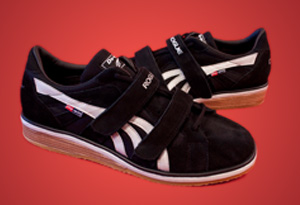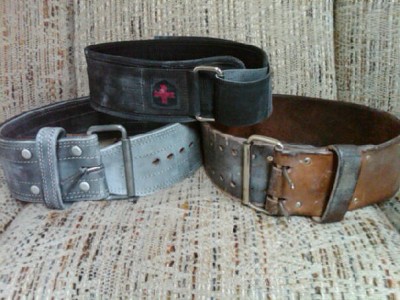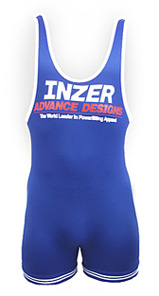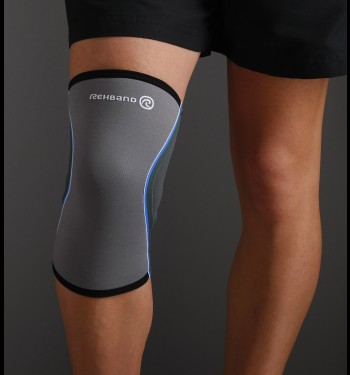Update version 1.4
Updated weightlifting shoe links
[spoiler show=”Show past updates” hide=”Hide past updates”]Update version 1.31
Added singlet, shoe (Canadian) and belt (UK) links
Added section on knee sleeves
Added section on chalk[/spoiler]
I get questions periodically on singlets, belts, shoes, etc. This post will link to some older articles, touch on some important points, and open the forum for the input of the readers. Let’s make this a comprehensive gear post where someone can learn about, compare, and find links to various products. It is important to note that 70’s Big is open to advertising for companies that sell lifting gear. Also, you’ll notice that we aren’t talking about squat suits or bench shirts because they are fucking irrelevant (more on this another time).
Shoes
Read about why lifting shoes are important here.

Summary:
Shoes will improve efficiency and safety when lifting.
1. The sole is wider, thus more stable (an important reason why lifting in Chucks is inadequate).
2. The sole is made of material that increases the coefficient of friction when articulating with the ground so that you don’t slip. This is obviously imperative when Olympic lifting but still useful for squatting.
3. The upper is typically made of leather as opposed to canvas, thus it is more stable when compounded with…
4. The metatarsal strap(s) help hold the feet in place to prevent foot-in-the-shoe movement. This is, again, imperative with Oly lifting, but incredibly useful for squatting.
5. Most importantly, the additional heel height (of about .75″) improves mechanics for squatting and pulling. The angle change in the ankle reverberates to the knee and subsequently hip to have a better balance of musculature around the knee and hip. When someone squats in lifting shoes for the first time, it always — ALWAYS — looks better.
6. The sole and heel are made of non-compressible material which prevents any spongy bounce from redirecting the force you are trying to apply into the ground. Yes, Chucks compress. Running shoes are ignorant; each rep is a new experience because of the cushioned sole. Not to mention those shoes don’t have the other qualities already listed.
Shoe Brands
Some times shoes are just called “lifting shoes” and other times they are specifically called “Olympic weightlifting shoes”. In either case, you’ll want the slight heel like the picture above. Avoid any that have a heel larger than one inch. Brands include Risto, Rogue, Pendlay (not direct link), Nike (another), Adidas (or try here), and VS Athletics.
Here’s a site that has various brands.
For Canadian buyers.
Some of the shoe brands only list one of their shoes. If you want to post a link to other brands, or a greater selection in each brand, do so in the comments and I’ll edit the section.
Belts
I’ve written about belts a lot, but I still get workshop attendees who don’t understand why they are necessary (same with shoes). Here are four links to information on belts with varying levels of detail.
One — Generally speaking
Two — types of belts
Three — how to break in a belt (video)
Four — a detailed post, look here for best info

Summary:
A belt most certainly does not “turn the abs off”, but instead makes them stronger to help aid in the Vasalva Maneuver, or increase in intra-abdominal and thoracic pressure that protects the spine in lifting. A belt functions on the abdominals, not the back. Thus, belts that are narrow in the front and flared in the back are irrelevant. The slight constriction of trunk volume by a belt with the same breath of air (a big breath) will result in increased pressure compared to no belt (volume down, contents same = pressure up — Boyle’s Law). The abs contract harder isometrically into the belt and get stronger quicker. Not only are the muscles getting stronger, but the additional pressure increases efficiency and safety. By choosing to not be safe and efficient, you are not only limiting your strength improvement, but doing so with crappier form and a higher potential for injury. Probably something you should think about.
Brands and Types
Good belt websites have changed a bit since this site has been active and I haven’t had to buy one lately, so I’m unfamiliar with the market. Please post belt sites to the comments with some quick comments. It’s important to note that suede belts are used in strength training (including powerlifting competitions) while the velcro belts are typically only used in Olympic weightlifting. Also, in some powerlifting federations you can’t wear velcro belts.
Best Belts
Safe USA
For the UK
Pulling Straps
Unless you’re pulling well over twice your body weight or have been lifting at least for several years, you won’t need to worry about straps. If you are, then I always look to Iron Mind for straps. The world’s strongest men use them. I mean that literally, they use them in the World’s Strongest Man Competition. There are various kinds of various lengths fit for Oly lifting (the shorter, sewn kind) or heavy fat bar pulling.
Iron Mind Straps — Note that there are two pages
If you have used other straps, feel free to post the brand links to the comments.
Singlets
Singlets are necessary for competition. Styles and colors can vary; Olympic weightlifting are typically spandex material with longer legs and powerlifting singlets typically have shorter legs. I will point out that singlets are made of stretchy material and it’s better to have a singlet that’s a bit too small than too big. I’d suggest getting a size smaller than what the company fits you for — I bought one that was a bit too big and the straps irritatingly slid around (of course it was too small for my thighs).
Brands
CustomSinglets.com
Singlets.com
Cliff Keen
Brute Wrestling
Knee Sleeves
Knee sleeves aren’t required, but some find utility in them. They provide some stability and proprioception feedback that will help the lifter feel more comfortable. More importantly, they will trap heat that the leg is giving off to keep the knee warm. This will provide external warmth (as opposed to internal via blood flow) to the superficial ligaments and tendons of the knee, particularly the patellar ligament and tendon. When these structures are warmed, they are more pliable and less likely to experience pain or be hurt. Powerlifters and weightlifters both use knee sleeves.
Rehband knee sleeves are top of the line. They are expensive (around $60 for a pair) and made of neoprene, but they will be the best warmth and support for knees. They won’t provide an ergonomic aid to the movement like knee wraps would, yet they will feel like they “help”.
The expensive Rehbands aren’t mandatory if you are having general knee soreness (which is usually caused by too much too soon, and can be alleviated over time unless there is an existing injury). I used cheap sleeves from a local sport store. They were black and a similar material to an ace bandage and were five dollars each. It provided the warmth I desired at a low cost. I wore them to nationals. It’s noteworthy that this section isn’t referring to knee sleeves with a whole over the patella (I’d prefer to not have a whole to keep the warmth in).
Chalk
Chalk is necessary for lifting, especially when sweating. It increases the coefficient of friction when your hand touches a bar. Your friends can even draw phallic symbols on your back with it. It is available in lots of places online, whether you are searching lifting or mountain climbing chalk. Most lifters will agree that having the actual block (or pieces of it) to rub on your hands is preferable to a bowl of dust.
Amazon Chalk Selection
Other
If there are any other pieces of gear you think should be on this page (like supportive wrist straps), then give your thoughts in the comments. Feel free to comment on brands that you actually own so that potential shoppers can get objective feedback. Don’t give your thoughts on something you haven’t actually used consistently over time.



Pingback: » Q&A – 11
Pingback: » Q&A — 23
I asked about deadlifting shoes last year. Since then I’ve bought some slippers to use in USAPL meets that require some sort of footwear. I’ve been training with them on for two months now and like them. They’re just like lifting in socks, except the rubber provides some grip on the floor. I got these: http://www.liftinglarge.com/deadlift_slippers.aspx
They cost $14 including shipping and came in the mail literally 2 days after I placed the order.
Socks are also required for deadlifts at USAPL meets, and probably in many other federations. They provide a small amount of protection for the shins. It’s really, really, really important to look cool while lifting, so I’m glad Justin recommended this site for me last year. I got a pack of these bad boys and haven’t looked back: http://www.skatersocks.com/25inchsocks.html
If anyone is looking for a lifting belt I have a BestBelts 13mm belt that has almost zero use. I went to a thinner 10mm belt and have no need for the 13mm. 33.5″ center hole, royal blue, 13mm thick, 4″ wide. Email me at velociraptor dot implant at gmail dot com if interested.
Pingback: Weightlifting Belts – Why and Which to Use - All Things Gym
Pingback: 120326 « CrossFit Vineland
Wanting to get my first pair of shoes. Looking at either the Rogue Do-wins or the Adidas Ironworks III also from the rogue site.
Which do you recommend/
Pingback: Belts Redux |
Pingback: Best Ab Belt 2012 Olympics Opening